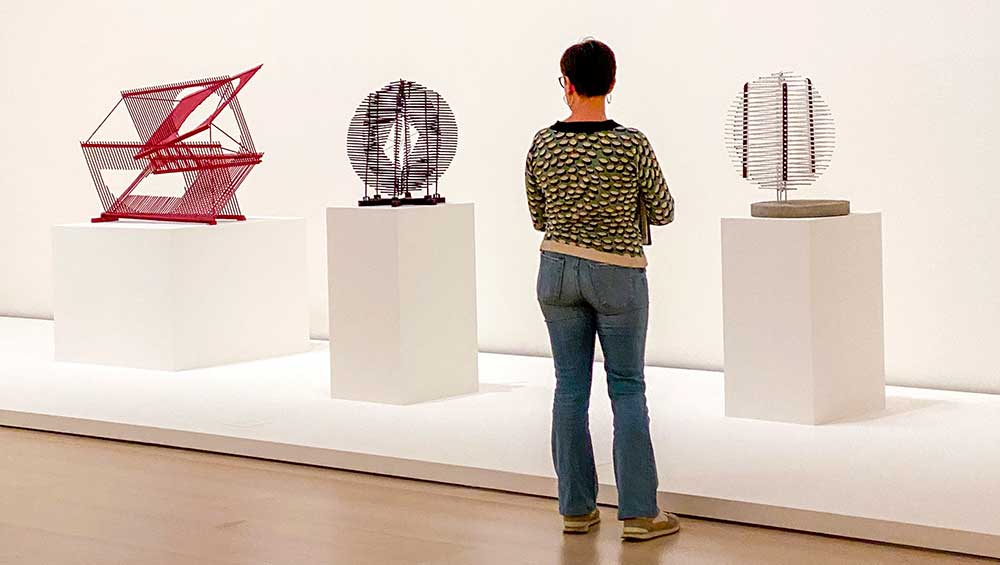
Gego: Measuring Infinity, installation view, Guggenheim Bilbao, 7 November 2023 – 4 February 2024.
Guggenheim Bilbao
7 November 2023 – 4 February 2024
by VERONICA SIMPSON
My interest in this show was piqued by a rave review in the New York Times earlier this year, when it was at the Guggenheim New York. Here Gego’s sculptures and prints – which capture the essence of movement and energy – were situated along the sweeping ramps of the building’s circulation route, amplifying their choreographic impact. At the Guggenheim Bilbao, however, a building whose form is permanently rippling and restless, her works are boxed into an orthodox, L-shaped ground-floor gallery. But perhaps that helps to anchor them in their own space and time.
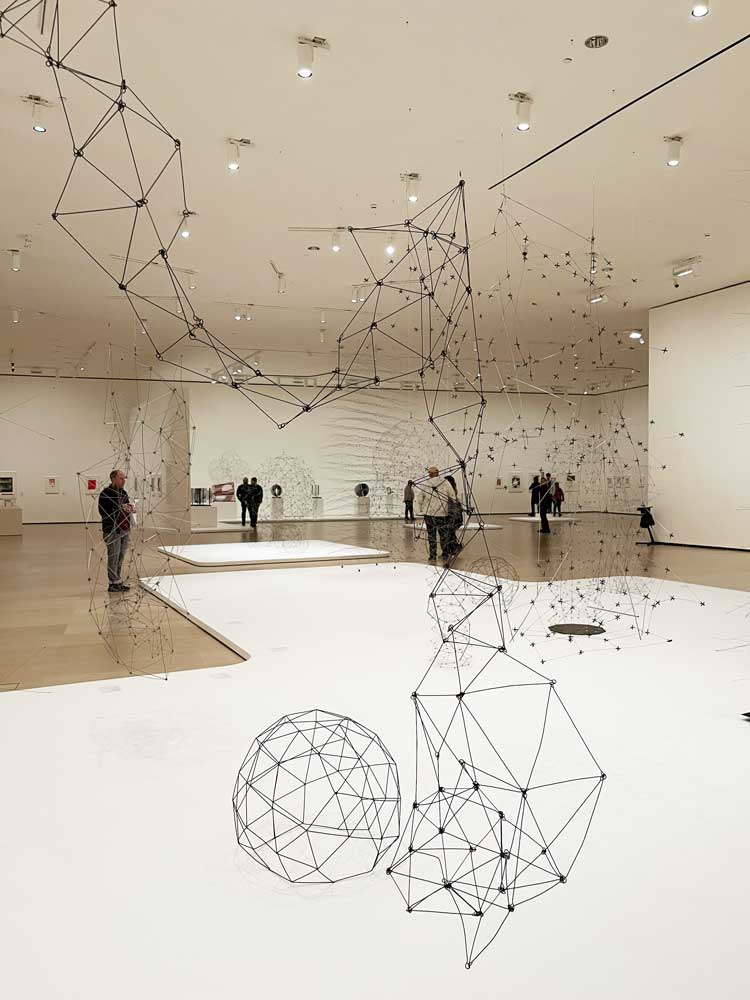
Gego: Measuring Infinity, installation view, Guggenheim Bilbao, 7 November 2023 – 4 February 2024. Photo: Veronica Simpson.
Gego was born Gertrud Goldschmidt in 1912, to a secular Jewish banking family in Hamburg. In 1939, she fled Nazi Germany for Venezuela, apparently the only nation to offer her a visa. Initially, she carried on working in engineering and architecture, for which she had trained at the Technische Hochschule Stuttgart. As we move around this exhibition, we learn that she had ambitions to design textiles, furniture and lighting, to which end she set up a workshop in Caracas, before devoting her energy and attention to a full-time career as an artist. She continued to live in Caracas until her death in 1994.
Given that her reputation was built on renderings in wire and metal, the first surprising impression is how strong her works on paper are. On the immediate left of the entrance are three paintings that reveal her acute sensitivity to colour as well as form. They capture the seismic shift in light, palette, climate and landscape that must have registered on a visceral level, when she landed in Venezuela having left the cold climes of northern Germany. In Araya Beach (1955, a gouache on cardboard) the sun bathes a few simple huts in a buttery yellow glow, the sea animated by thick ridges of blue, grey and pink. Even more atmospheric is the range of deep, nighttime blues in the tempera on paperboard work to its right, also from 1955, or the delicate dawn tints captured in the earlier (1954) work beside it. By this time, she had been in Venezuela for more than a decade, but it was in the 50s when her transition to artist was completed.
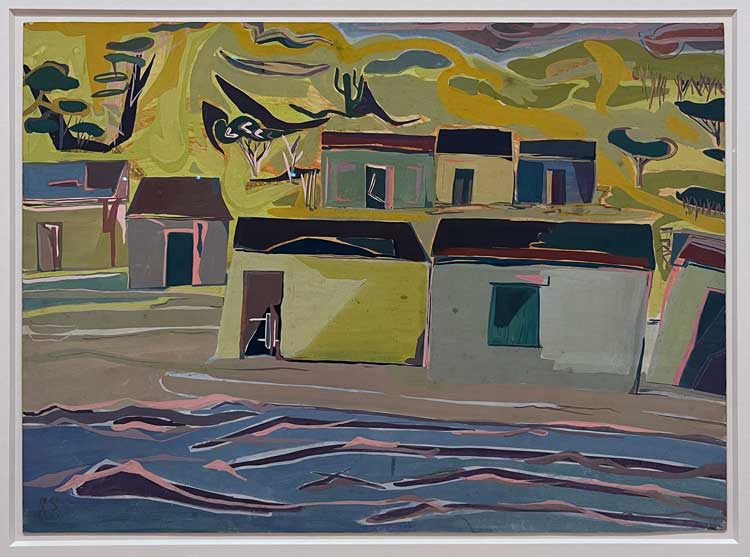
Gego (Gertrud Goldschmidt). Araya Beach, 1955. Gouache on cardboard. Photo: Veronica Simpson.
There are four decades of her work here, revealing an intense and questing spirit, as well as her skill in exploring and expanding how much tension, space, volume and character she could convey through simple arrangements of lines, whether on paper or off.
Given the amount of work here – nearly 150 items – and the quality of it, it is a surprise that this is the first major retrospective of her work, particularly since she is now lauded as “one of the most significant artists to emerge from Latin America during the second half of the 20th century”, according to the Guggenheim’s text. She was a key figure emerging within the region’s celebrated deep dive into kinetic art and geometric abstraction, ranking alongside Lygia Clark, Carlos Cruz-Diez, Hélio Oiticica, Mira Schendel and Jesús Rafael Soto.
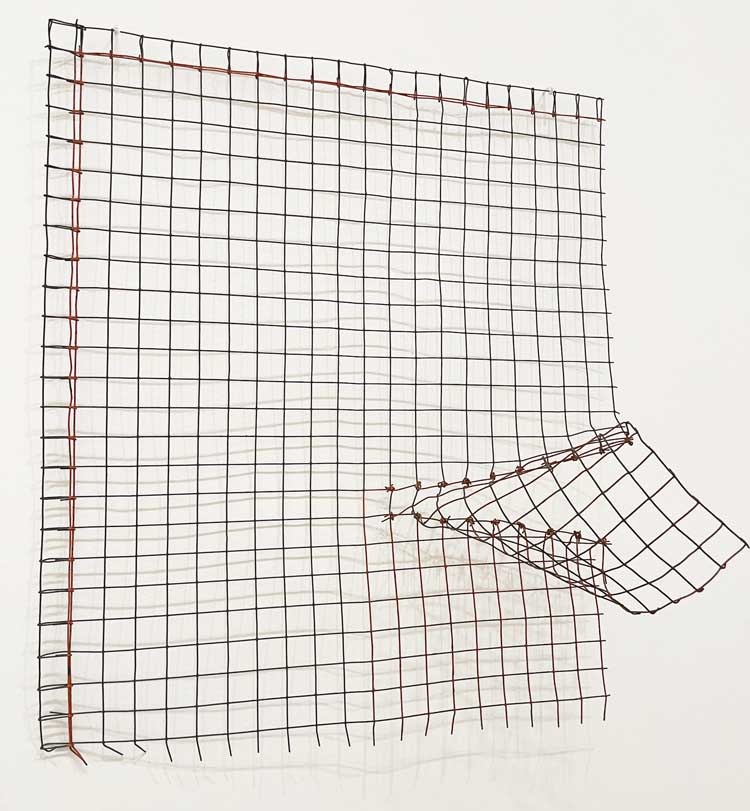
Gego (Gertrud Goldschmidt). Drawing Without Paper, 1985. Photo: Veronica Simpson.
The works are arranged thematically, starting with her Drawings Without Paper (1976-88). A brilliant array of experimental pieces rests along one wall, wrought with wire and recycled scraps of metal and hardware. She is playing with notions of the grid, exploring the tension between 2D and 3D, expanding and disrupting our expectations of familiar forms and structures with the lightest touch.
A simple square of wire is embellished with a dazzling, disrupted counterpart, hanging diagonally off its lower right-hand corner (Drawing Without Paper 79/2, 1979, in bronze, steel, thread and iron). A wire rhomboid hints at a feline face, with a bristling moustache of whiskers punctuating its lower mid-section (Drawing Without Paper 86/1, 1986, in steel and iron).
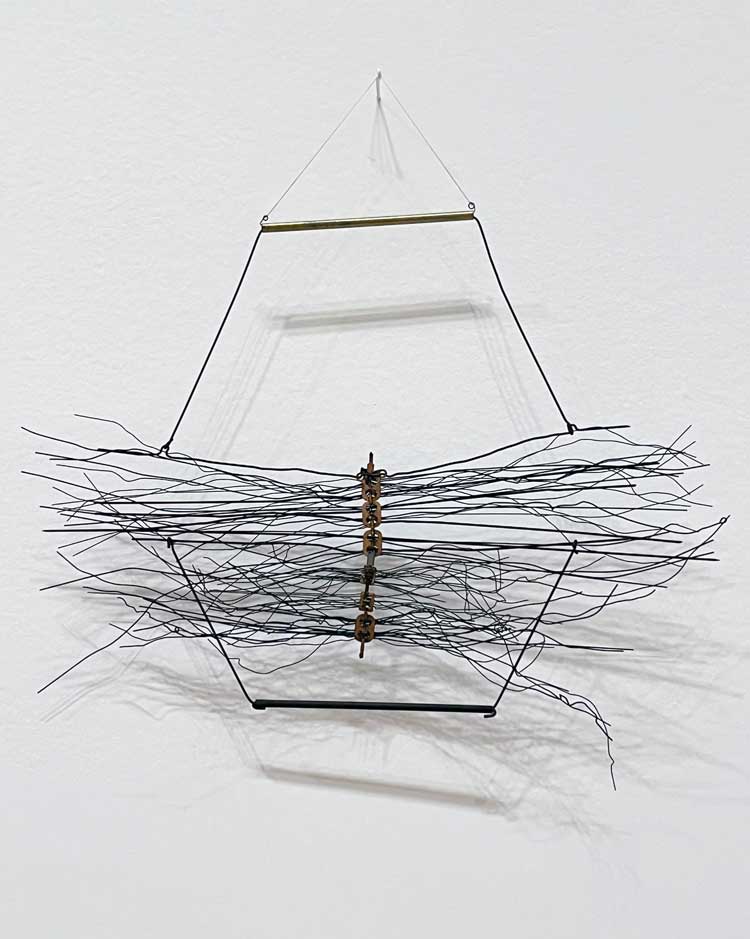
Gego (Gertrud Goldschmidt). Drawing without Paper 86/1, 1986. Installation view, Gego: Measuring Infinity, Guggenheim Bilbao, 7 November 2023 – 4 February 2024. Photo: Veronica Simpson.
The simplest, chequered square bursts into a floral fold at its right-hand edge. These delightful “drawings” segue into a section titled: Last Works: Weavings, Bugs and Small bugs (1987-91), marking a shift to smaller-scaled items in later life. Our first encounter with the “weavings” is a dazzling collection of small collages, where she deploys sliced strips of photographs from magazines into tightly woven constellations of colour and texture. The “bugs” (bichos) in question apply to a wide plinth full of “chaotic assemblages” using scraps and remnants repurposed from other sculptures, displaying more eccentric, organic shapes. There is a small display of textiles around the corner, with a wall text explaining Gego’s aforementioned 1940s venture into designing furniture, lamps and rugs. One of her large-scale untitled tapestries is displayed nearby, a creation of interlaced synthetic cords. An Untitled work under glass from 1956 shows how sparklingly articulate and energised even an assemblage of cardboard, fabric, cork, cellophane and felt-tip could be in her hands.
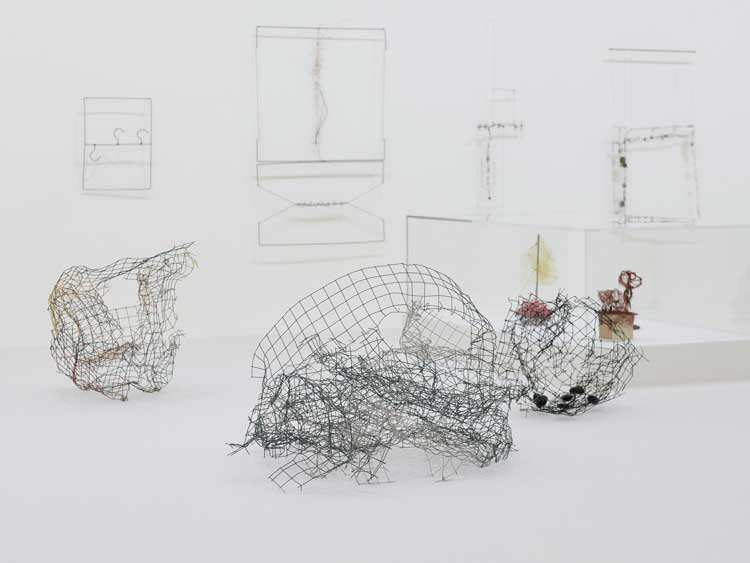
Gego: Measuring Infinity, installation view, Guggenheim Bilbao, 7 November 2023 – 4 February 2024.
The central area of this L-shaped gallery is given over to Gego’s Reticuláreas (areas of nets) (1969-82), the large-scale, site-specific installations for which she is best known. Most of these are presumably the “sketches” she carried out before the main installations, as none of the latter survive. The netlike works she spun, by hand, within rooms or staircases, were regarded as groundbreaking in their time, equal to the “penetrable” structures of her aforementioned peers and shown alongside theirs in Caracas and New York in 1969. Black-and-white photographs on the walls reveal the installations in situ, plus drawings and letters detailing their construction and evolution.
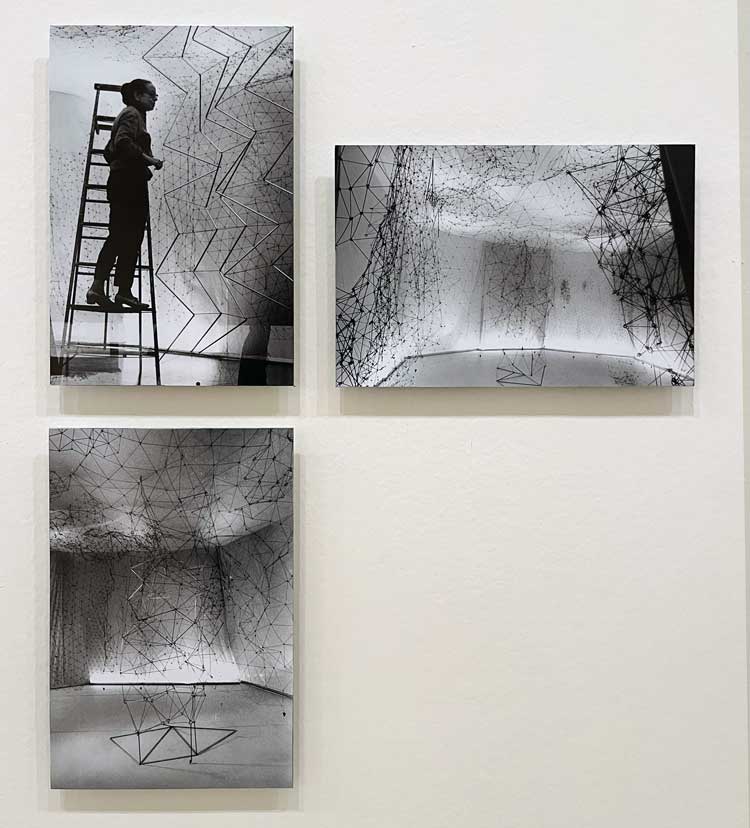
Photographs of Gego installing her Reticuláreas. Photo: Veronica Simpson.
Some of the most rewarding works are to be discovered in the Tamarind Lithography Workshop and Reticular Studies (1963-70) section. Gego’s milestone developments in this sculptural form were achieved after her first visit to the US in 1959, which she subsequently visited frequently, accepting invites to the Tamarind Lithography Workshop in Los Angeles, where she became an expert printmaker. The prints are as vivid an evocation of the thinking and concept behind her sculptural forays as one imagines the works themselves were. The same is true of an adjacent area, titled Parallel Lines (1957-67). Assorted works on paper using ink and felt-tip practically burst off the page with their vigorous investigations of depth and space. The delicate lines in a series of etchings equally vibrate with tension as they intersect and overlap. More than a dialogue, it is a dance she sets up between presence and absence, stillness and flow. No wonder her work was dubbed kinetic, even though there were no moving parts.
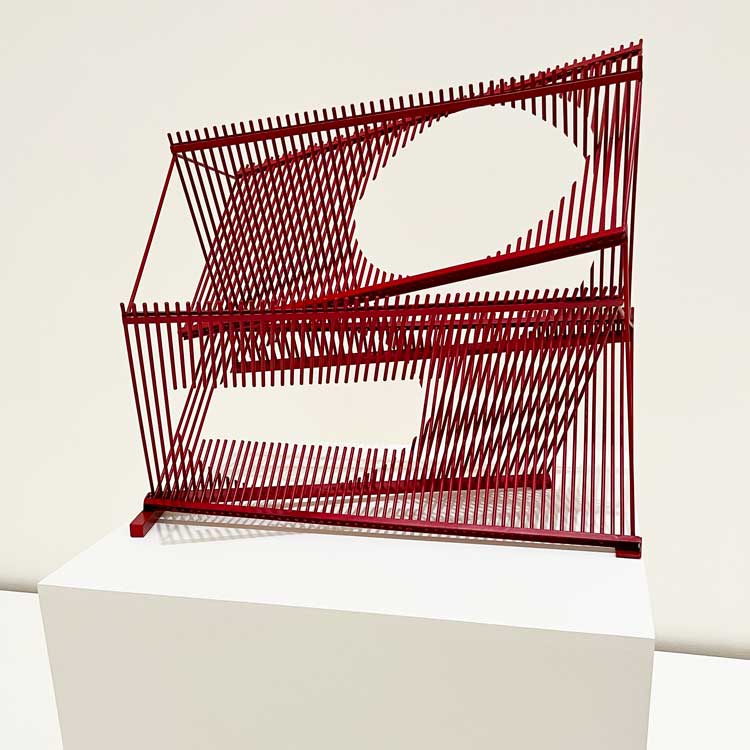
Parallel Lines, installation view, Gego: Measuring Infinity, Guggenheim Bilbao, 7 November 2023 – 4 February 2024. Photo: Veronica Simpson.
To turn away from these wall works and encounter the 3D pieces ranged around them in this corner of the gallery is to meet the same family of vibrant, abstract characters in 3D imaginings. It is interesting to reflect that, had she arrived in the architectural and engineering arena 40 years later, in the age of Parametricism, she might have stuck with architecture, joining the likes of Zaha Hadid with her fantastical forms. But knowing how problematic certain curvaceous buildings of glass, concrete and steel can be to those who have to inhabit them – or hang works of art on them – perhaps we should be glad she delivered her insights in portable form, odes to her own vital, supremely inventive aesthetic quest.